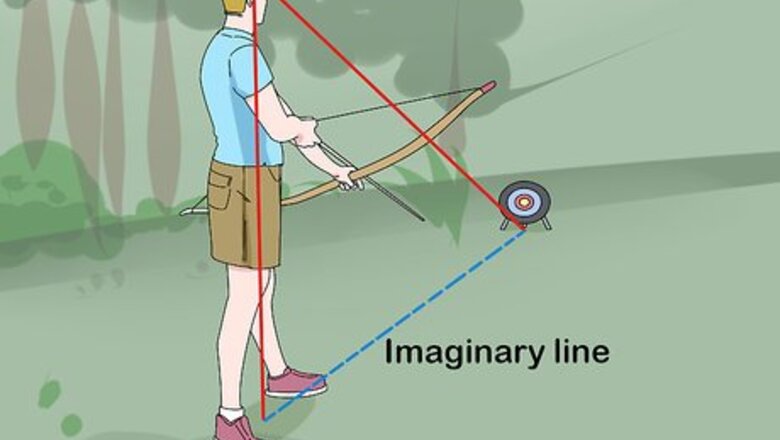
views
Shooting a Drawstring Bow
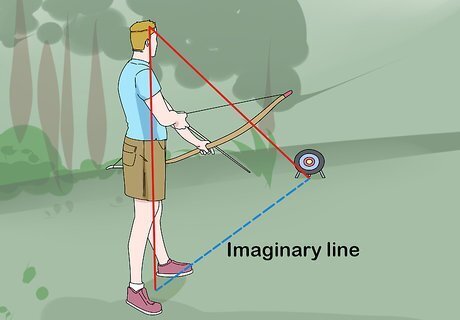
Line your body up perpendicular to the target. When you’re ready to shoot, line yourself up so that, if you drew an imaginary line from yourself to the target, the line would go across your feet. If you are right eye dominant, hold the bow with your left hand, point your left shoulder to the target, and handle the arrow and string with your right hand. If you are left eye dominant, do the reverse.
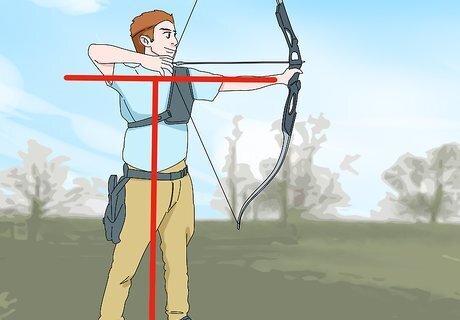
Stand upright and place your feet shoulder-width apart. Pinch your buttocks together to bring your pelvis forward. Keep your back erect so that, when you pull the string, your arms and shoulders form a "T” shape. Your stance should be comfortable enough to hold for long periods of time, but also firm and alert.

Point your bow down and attach an arrow to the string. Point your bow toward the ground and place the shaft of an arrow on the arrow rest. Attach the back of the arrow to the bow string via the small plastic component with a groove in it, called the nock. If the arrow has 3 vanes, or fletching feathers, orient the arrow so that a single vane points away from the bow. Then, place the arrow below the nock bead or, if there are 2 beads, in between them.
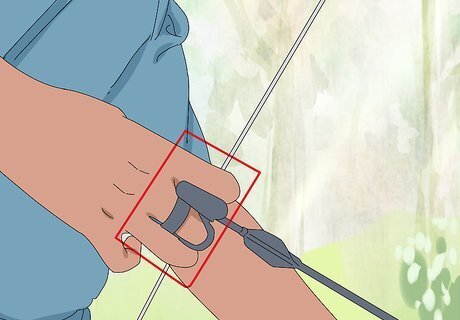
Use 3 fingers to lightly hold the arrow on the string. If you’re shooting with a sight, place your index finger above the arrow and your middle and ring fingers below. This is called the Mediterranean draw or "split finger" style. If you’re shooting without a sight, place all 3 fingers below the arrow, which will bring the arrow closer to your eye. Use your thumb to support the back of the arrow and keep it straight.
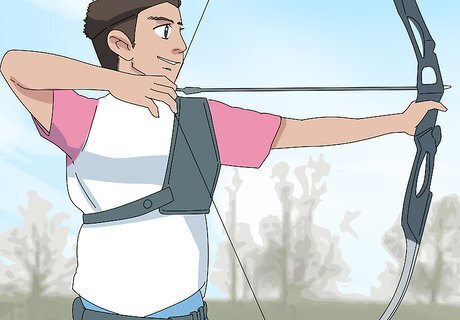
Point your bow toward the target. With your fingers on the drawstring, raise your bow and hold it out toward the target. Your inner elbow should be parallel to the ground and the bow should always remain vertical. When held properly, you should be able to look straight down the spine of the arrow.
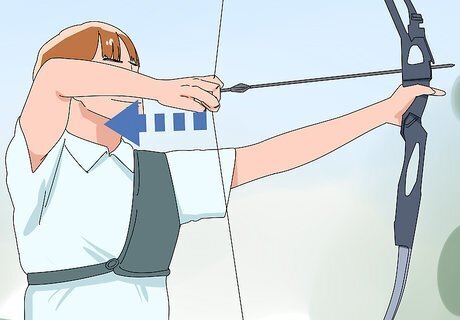
Use 3 fingers to pull the bow’s drawstring back toward your face. Use your back muscles for strength and let your arm stay as relaxed as possible. Keep pulling until the bow feels tight, then use your chin, ear, or another body part as a reference point, that way you can draw the string back to the same spot each time. Try to draw the string as far back as possible. This increases accuracy and dampens the effect of wind and gravity. When you pull back the string, lift your elbow up. This makes your shoulder muscles work instead of your arm muscles.
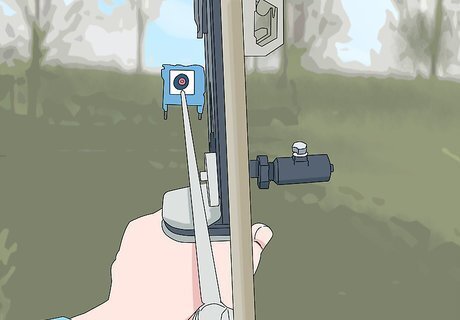
Aim at your target. Most casual archers will use a technique known as instinctive shooting. In this method, simply point your bow so that the tip of the arrow lines up with your target. If you want to fine-tune your aim, try purchasing an adjustable sight that attaches to the front of your bow. When shooting, you can either close your non-dominant eye or keep both eyes open.
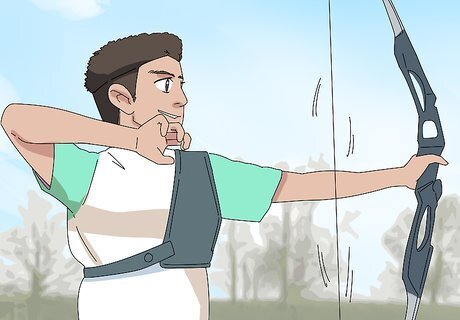
Release the arrow by relaxing the fingers on your string hand. The goal is to get a clean release, meaning the bow leaves your fingers with as little slowdown and interference as possible. While this may sound simple, the manner in which you release your fingers from the bowstring can impact the arrow's flight, and any unintended flinches or wobbles can knock it off course. After releasing the arrow, wait until it hits the target to lower the bow. Do not move your hand forward to "boost" the arrow while you shoot. Remain still for the best shot possible. Pay attention to the bow’s recoil or follow through, as it may indicate problems with your form.
Firing a Crossbow

Pull or crank the string to cock the bow. If you’re using a manual crossbow, place your foot into the stirrup located at the front of the bow, then pull the string toward the back of the device until it cocks. Make sure to keep the string as even as possible. For crank crossbows, attach your crank to the device if necessary, then simply turn the crank until the bow cocks.

Load the crossbow with an arrow. After cocking the bow, place a crossbow bolt or arrow into the barrel of the device and line the cock vane up with the barrel channel. For safety, load the arrow from the top of the device, keeping your hand away from the main chamber and the front of the bow at all times.
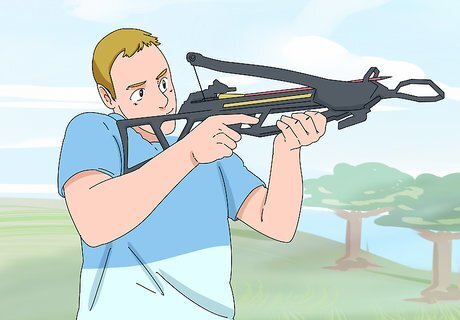
Bring the bow to your shoulder. Similar to a rifle, bring the crossbow up to your dominant shoulder and either push it into the pocket of your shoulder or let it sit on top of your shoulder. Then, place your non-dominant hand below the crossbow to steady it, making sure to keep your fingers away from the main chamber. Do not freehand your crossbow as it can lead to inaccurate and dangerous shots. Freehanding is when someone holds their crossbow in 1 hand and attempts to shoot it.

Aim your shot using the bow’s sight pin or scope. If your crossbow has a scope, peer through it and line the aiming reticles up with your target. Make sure to check your scope’s user manual so you know what each reticle means. If your device does not have a specialty scope, line up your shot using the crossbow’s peep sight or other alignment device.
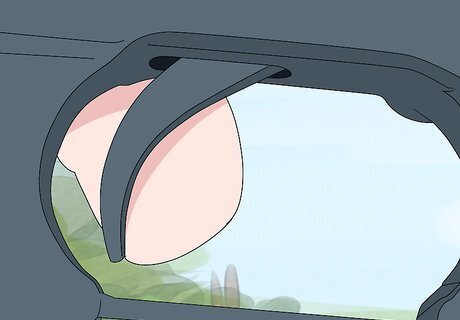
Fire your crossbow. When you’re ready to shoot, hold your crossbow steady and double check your scope or sight. Then, pull the trigger like you would on a gun. When the arrow releases, you’ll hear a slight pop from the trigger.
Gearing Up
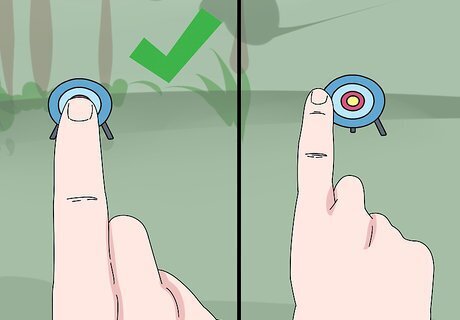
Determine your dominant eye. With archery, eye dominance is more important than hand-dominance because your dominant eye is what will handle aiming and judging distances. To figure out which of your eyes is dominant, point your finger toward a distant wall or object and close 1 of your eyes. If your finger appears to jump, you closed your dominant eye.
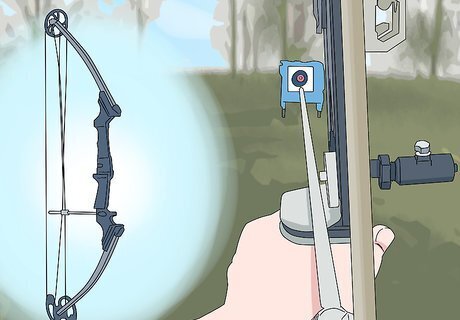
Buy a bow that matches your dominant eye. Most archery equipment is labeled as "right-handed" or "left-handed" in reference to which hand pulls back the bowstring. If your dominant eye does not line up with your dominant hand, purchase equipment for your weaker hand. Though it may take your hands some time to adjust, picking gear based on your eyes will boost your precision. Typically, you can use crossbows in either hand.

Choose arrows to go with your bow. For crossbows, look for bolts that adhere to the length, density, and nock recommendations given by your bow’s manufacturer. When dealing with drawstring bows, purchase arrows that are about 2 in (5.1 cm) longer than your draw length. If possible, purchase high-quality arrows made from carbon fiber, aluminium, fiberglass, or wood. If you’re planning to shoot targets, get arrows with field point heads. If you’re going hunting, use broadhead or blunt tips instead. Judo points are also used. They have small clasps that grip onto the prey after you shoot it. To find your draw length, pull back your bow as if you were going to shoot it. Then, have a friend measure the distance between the front of the bow and the back of the string.
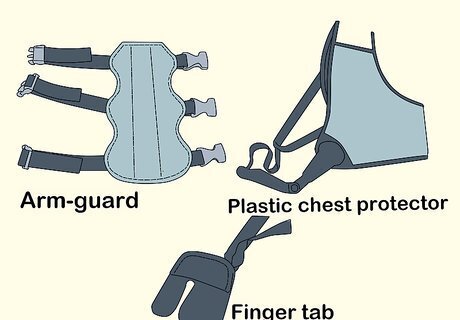
Purchase protective gear. Certain pieces of equipment are essential for ensuring both a safe and enjoyable shooting experience. Some items to consider buying include an arm-guard to cover you bow arm and protect it from bowstring slaps, a plastic chest protector to prevent string burn along your chest, gloves or a finger tab to protect your hands from string injuries, and a quiver to hold your arrows. The finger tab/glove is the most important. Without it, you can get permanent nerve damage even on a 20 lb. bow. Trying to tough it out is not a good option even if you have developed callouses by playing guitar or something else.

Buy targets and other practice equipment. For archery, the best way to practice is with a personal target. These come in a variety of forms including bag targets, which work well for simple point heads, foam targets, which can handle notch and broadheads, and 3D targets, which look like wild animals, zombies, and other creatures. Along with targets, consider buying things like: Strength training bars Release trainers Practice bows


















Comments
0 comment